|
I’ve been down another rabbit hole recently, reading up about Poles in the Napoleonic era for a Sharp Practice game about the death of Poniatowski. There is an excellent facebook group called “Epoka Napoleońska”, which often posts albums of uniforms and battle scenes from the period. Recently this group posted a link to an article from the Polish magazine “Historia”, published on 27 February 2023, about the origins of the Polish national anthem. It was so interesting that I decided to summarise it here. The story begins with the Third Partition in 1795, when the Polish State disappeared from the map, her territories shared out between Russia, Austria and Prussia. In 1797 the Polish Legions were raised in Italy under French sponsorship, attracting former soldiers and young patriots in exile. Their commander was General Jan Henryk Dąbrowski, an experienced officer who would serve the Polish cause throughout the Napoleonic wars. Also in 1797, the Polish nobleman, politician and writer, Józef Wybicki, a friend of Dąbrowski who had joined him in Italy, wrote a poem that became known as “the Song of the Polish Legions in Italy”. The words were set to the music of a popular Mazurka and sung for the first time on 20 July 1797 in Reggio Emilia in Italy. The Dąbrowski’s Mazurka soon became the Legions’ marching song and its popularity spread. In 1806 it was first printed in the partitioned Polish territories, and from then on, it became an enduring symbol of the ambition to regain independence. Despite being banned by the partitioning powers, the song kept its popularity and eventually became the official national anthem of the restituted Poland in 1927. The loyalty and courage of Polish troops in Napoleon’s service is legendary. The words of Dąbrowski’s Mazurka help demonstrate how tightly the dream of restored nationhood was bound to the person of the French Emperor. Small wonder they fought so hard for him, right up to the end. The original song had six verses, though verses four and six have been dropped in modern times (you can guess why) . Some of the words have changed slightly since 1797 but the gist is exactly the same. My loose translation is below Poland has not yet died As long as we are alive We shall take back by the sword What foreign powers have stolen. Refrain: March, march, Dąbrowski From Italian lands to Poland Under your command We shall unite with the nation. We will cross the Vistula, cross the Warta We will be Poles Bonaparte has shown us by example How we shall be victorious. Refrain Just as Czarniecki returned to Poznan From across the sea To save the fatherland After the Swedish partition. Refrain Neither German nor Muscovite shall settle (our lands) When, having drawn our sword, Our watchword will be “Unity And our Fatherland”. Refrain So the father says To his weeping (daughter) Basia “Hark! It seems our (lads) Are beating the military drums”. Refrain At this we all say with one voice “Enough of this captivity! We have the scythes of Racławice Kościuszko, if God wills it”. And the Polish original text: Jeszcze Polska nie umarła,
Kiedy my żyjemy. Co nam obca moc wzięła, Szablą odbierzemy. Refrain: Marsz, marsz, Dąbrowski —Do Polski z ziemi włoski —Za twoim przewodem —Złączym się z narodem. Przejdziem Wisłę, przejdziem Wartę Będziem Polakami Dał nam przykład Bonaparte Jak zwyciężać mamy. Refrain Jak Czarniecki do Poznania Wracał się przez morze Dla ojczyzny ratowania Po szwedzkim rozbiorze. Refrain Niemiec, Moskal nie osiędzie, Gdy jąwszy pałasza, Hasłem wszystkich zgoda będzie I ojczyzna nasza. Refrain Już tam ojciec do swej Basi Mówi zapłakany Słuchaj jeno, pono nasi Biją w tarabany. Refrain Na to wszystkich jedne głosy Dosyć tej niewoli Mamy racławickie kosy Kościuszkę Bóg pozwoli. Refrain
0 Comments
On 17 October, Dan, Harry, Will and I played a game of Lasalle. If I’d been thinking about the date I’d have run a Leipzig scenario but my brain was on go-slow and we played an 1809 game instead. The scenario was “Feeling for the enemy”, Friant’s attack towards Ober Sanding on 21 April 1809. It is downloadable here. The scenario begins with Rosenberg’s Austrians deployed along the Regensburg-Eggmühl highway facing West and Friant’s French arriving in the south west corner of the table. The French aim is to take the village of Ober-Sanding on the Austrian right, which would cut the highway and hence the Austrians’ connection to Regensburg. The table is unusual in having a lot of woodland, especially on the French side of the valley. Dan took the Austrians and Will and Harry, the French. Friant versus RosenbergThe game began with the French 15th Light, the best French regiment, advancing eastwards through the woods in the centre. Dan had deployed two Grenzers battalions on the edge of the woods, ready to slow the French down, but the 15th despatched them almost immediately (to my embarrassment since I had encouraged Dan to place them there). Meanwhile the French left, comprising 6 battalions, moved northwards through the woods and came out opposite and slightly overlapping the village. Up to this point, Dan had had atrocious luck with his dice rolls, his artillery barely troubling the French as they emerged from the woods. Also his reinforcements failed to show, which was less surprising since they needed two sixes to appear (each turn the players roll a number of dice equal to the turn number. Standard reinforcements arrive when one 6 is rolled; delayed reinforcements like Dan’s require two 6s). Fortunately for him, Dan began rolling better as the French attack on Ober Sanding started. As Harry now had to leave, Will assumed full command of the French and began his attack on the village with three battalions in line and three in battalion mass to the rear. His firing reduced the garrison to rubble but Dan was able to race a reserve battalion into the village before the French could occupy it. This battalion was then assaulted by two French battalions who were repulsed in short order. Meanwhile Dan advanced his centre to support his village and, at just the right moment, his artillery and musketry so disrupted the 15th Light that it ceased to be a factor in the game. Post-match analysisThe game ended with Will still outside the village but his reserves ready to mount another assault; the French centre incapable for now of forward movement; and the French right poised to put pressure on Dan’s outnumbered left. Dan’s centre was well-placed and holding their own and he still held the town on the right but he no longer had a reserve available should the garrison be bundled out by the French assault. Dan’s off-table reinforcements were still refusing to appear.
We agreed the game was a draw since it could still have gone either way. I’d give bragging rights to Dan however as I realised too late that the scenario heavily favoured the French, in two important respects. First, the French had such a big skirmish advantage that they went first every turn and had way more momentum than they needed. This negated any challenge arising from moving through the heavy woodland. Second, the French reinforcements only needed to roll one 6 to arrive, which happened quickly and gave them too much of a numerical advantage. After the game I amended the scenario to reduce the French skirmish advantage (though they do still have one) and to require reinforcements on both sides to roll two 6s before they could appear. I hope this will make the Austrian task a little easier. The scenario and orders of battle were taken from John H Gill’s Thunder on the Danube (volume 1). The Lasalle rules worked well and Will and Harry, both new to the rules, picked them up effortlessly. Next time, I’d like to try the same scenario using Soldiers of Napoleon to see how it compares. I was grateful to all players for the enthusiasm with which they assumed their Napoleonic roles! I have been gathering ideas for a Sharp Practice scenario of the last moments of Prince Józef Poniatowski, Commander in Chief of the army of the Duchy of Warsaw, who died on the last day of the battle of Leipzig in October 1813. I found two accounts in Polish, one by Mariusz Lukasiewicz in his book “Armia Ksiecia Jozefa, 1813” and the other in “Lipsk”, by Jadwiga Nadzieja. Both accounts drew on eye witness reports and are almost identical. The following is a translation of the account in Lukasiewicz, with a small comment from Nadzieja’s book. Introduction: On 19 October 1813, Napoleon’s army was retreating westwards from Leipzig, covered by a rearguard including Poniatowski’s Polish VIII Corps. The army had only one route out of the city and while the details are still disputed, the single bridge over which the troops were retreating was blown up prematurely, leaving several thousand troops of the rearguard on the far side, including the Poles. With the bridge gone, the only way the stranded troops could avoid death or capture was to cross two rivers, the Pleisse and then the Elster, either on makeshift bridges or by swimming. Meanwhile, Russian and Prussian skirmishers were racing to cut them off. “Poniatowski retreated from the water fountain, together with his headquarters staff and remaining soldiers. They moved through the Reichel‘s garden and the Rudolf garden towards the river Pleisse under fire from approaching enemy skirmishers. The cuirassiers and some chasseurs were still fighting. General Bronikowski strongly urged the commander-in-chief to swim his horse across the Pleisse. Poniatowski was reluctant to withdraw, but eventually ordered his escort to gain time with one more charge and then jumped into the river. The Pleisse was deep and fast moving due to the autumn rains and Poniatowski’s horse couldn’t make it up the far bank. Seeing him in trouble Hypolite Blechamps, a young French captain on the Headquarters staff, ran to help. (Jadwiga Nadzieja says he was assisted by another aide, Ludwig Kicki, who was shot soon after dragging Poniatowski to the bank). He freed Poniatowski from his horse and pulled him onto the riverbank. The prince now proceeded for a time on foot. As he retreated through the gardens he was wounded for a fourth time, this time by a musket ball in his side. The wound was serious and only quick attention stopped him from bleeding to death. Poniatowski fell unconscious into the arms of his escort but soon regained his senses. His staff begged him to hand over command to one of his generals and surrender to the Allies so his wounds could be properly treated. Now half-conscious, Poniatowski refused, saying that his honour and duty to his Fatherland would not permit him to do this. With the help of his adjutants, he mounted another horse and supported from both sides, rode along the River Elster towards a crossing place that had been indicated by an officer of engineers. Allied troops had by now already reached the river and some had even crossed to the other side, shooting at the soldiers as they tried to swim to safety. Bleeding heavily and losing consciousness every few moments Poniatowski’s path was suddenly blocked by an enemy detachment and he turned his horse and jumped in the river. The horse managed with difficulty to reach the far bank, but as it scrambled to get out of the water, Poniatowski was hit again by a musket ball. He slid off the horse into the water and began to drown. Captain Blechamps again jumped in to help him, but soon they both disappeared in the current and neither was seen alive again. Poniatowski’s corpse was recovered from the Elster by a local fisherman on 24 October and his identity confirmed by Polish prisoners.” I have uploaded a new scenario here for Soldiers of Napoleon (Scenario SoN 3), covering Girard’s 7th Division’s defence of St Amand La Haye during the Battle of Ligny on 16 June 1815. I started with the Lasalle scenario that I had already written for the same action, but was soon moved to revisit the sources because of an interesting difference in approach between the two rule sets.
Lasalle 2 makes all units a standard size (Russian artillery excepted). Lasalle 1 did have an option for large battalions, but even then there were only two sizes. Sam Mustafa is an accomplished designer who tests his rules extensively before releasing them. Lasalle 2 works very well indeed and there is no doubt that standard unit sizes (and hence frontages) makes for smooth play. The argument for standard sizes generally runs that it is hard to know exactly how many men were present at any given point and that on average, most battalions were around 500 men strong after a few months campaigning. If an army’s battalions were seriously understrength, as the Russians often were in 1813, the player is free to represent two actual battalions with one model battalion. Fair enough. I didn’t give much thought to this approach until reading through Soldiers of Napoleon. The approach to unit creation in Soldiers of Napoleon is more fluid than in Lasalle 1 or 2. A battalion can be any starting size from 2 to 6 ‘stands’ and the rules for firing, melee and morale management are geared for this. Looking at the orders of battle n the 1815 campaign, I was struck by the wide variation of battalion strengths between the French and Prussian armies. On the whole, Prussian battalions are significantly larger than the French. Now, at the scale of a divisional fight, the difference in battalion sizes could have a significant impact on play. So in adapting the Girard scenario to SoN, I have tried to reflect actual unit sizes in the order of battle (using the ratio of 132 infantry or 100 cavalry to a stand). Consequently, the largest unit is a Prussian Line battalion of 6 stands and the smallest is a 3-stand French battalion. I look forward to testing the effect this has on scenario balance when we play it on 11 September. I have a feeling that Girard is going to have a tough time hanging on to his real estate! SummarySoldiers of Napoleon provides a fast-moving and entertaining game. The cards pose tricky choices and have bags of period flavour. Our historical scenario gave moments of high excitement and a plausible outcome. Highly Recommended. DetailI recently bought Soldiers of Napoleon, the new card-moderated tactical rules by Warwick Kinrade, author of Battlegroup (and more besides). Five of us played our first game last week, using a scenario based on the fight for Markkleeberg during the Battle of Leipzig. This clash between Poles, French, Prussians and Russians seemed a good testing ground for the rules. The mechanics for movement, fire and melee are intuitive, straightforward and easy to learn. They hang together well, give good period flavour and on their own could have been the basis for a respectable IGO-YOUGO game. The card deck, however, takes things to another level. Every turn, each side receives a hand of cards linked to the number of Brigade or higher commanders on the table and players alternate card play until both run out. A card has three possible uses: to issue orders to a given number of units within a brigade; to rally units; or to play the special event that is described on the card. I’ve seen a couple of reviews that describe the rules at length so rather than repeat it all again, I’ll try to show how they affected our battle. I have put the Markkleeberg scenario here. I created it by following the game preparation procedure in the rules. The main Tactical Orders for both sides were chosen for them (Coalition attacking, Franco-Poles defending). The Order of Battle was fun to write because SoN doesn’t have standard unit sizes. A battalion or cavalry regiment can have between 2 and 6 stands, or roughly between 250 and 800 men. This suits the OoB for Markkleeberg well, as Helfreich’s 14th Corps was seriously understrength (so 3 stands per battalion), the Polish Cuirassiers only consisted of 2 squadrons/bases and the Prussian Landwehr battalions were numerous (but inexperienced). How the game playedWe played the scenario with two players per side. The Poles deployed their three brigades first, then the Allies set up in left echelon. Both sides had reserves off the table. The Russian 14th Corps advanced on the right; Coalition artillery in the centre bombarded the Polish hilltop position and the Prussian Foot screened Markkleeberg on the left. The Poles played a special event early on that allowed the Krakus lancers to advance far down the table and catch and destroy a Russian battalion in column (an incident that was only made possible by the special event: without it, the Russians would have had time to form square and fire at the threatening cavalry). This dislocated the Russian assault and bought time for the defenders, while the rest of Helfreich’s Corps formed square until the Krakusi retired. The Poles used another special event to bring in fire from the Grand Battery to their left rear. Phase 1 therefore gave the advantage to the defenders. In phase 2 the Russian assault got going again. A counter battery exchange in the centre went badly for the Poles and the Coalition artillery then whittled down the Vistula Regiment in the Polish centre as 14th Corps closed, supported by the Loubny Hussars. The French Reserve brigade arrived on the right and this, together with the Polish garrison of Markkleeberg, went forward to relieve pressure on the centre. Two Polish battalions chewed up a Prussian Landwehr battalion near the village and the Coalition left was now looking shaky. In response the Coalition played a special event to change the arrival location of their reserves to the Markkleeberg sector, which helped stabilise their left. In the final phase, the Coalition managed to shoot the Polish Division commander by playing a special event. The Russians then closed with the Polish centre and duffed it up enough to win the victory. The Love Child of Battlegroup and Longstreet?I love these rules! They do remind me of Longstreet, my (so far?) favourite rules for any period, which are also card-moderated and have a similar mixture of simple mechanisms and really challenging choices. Like Longstreet, SoN makes events possible that just don’t happen in many wargames, such as surprise attacks, missing ADCs, incoming damage from off-table batteries and stray bullets taking down senior officers. The sense of narrative and of history is really strong, which shouldn’t be a surprise from the author of Battlegroup.
All involved in this game want to play again and we all took away some thoughts on how better to play the cards next time. I have written a new scenario for Sam Mustafa’s Lasalle, based on the actions of Girard’s 7th Division at the battle of Ligny. Separated from II Corps, Girard was attached to Vandamme’s III Corps for the assault on the Prussian right flank, anchored on a string of villages along the Ligne brook. At the height of the fighting Girard was mortally wounded. The scenario covers the episode where Girard, having taken the village of Saint Amand La Haye, was counterattacked from the front and left flank. I chose this point in the action because the points values of the two sides at this point almost exactly match the standard weighted scenario in the rules, so 300 points of Prussians attacking 240 points of French. We havent played it yet so I can’t vouch for how it plays, but hope to do so in a month or so. The scenario can be found on the Napoleonic scenarios page here.
Building our experience with Lasalle 2The other day Chris, Paul and I played a game of Lasalle, using the scenario for Unter Laichling in April 1809, "Bristling with Guns", on the scenarios page here. Chris took the Austrians of Rosenberg’s IV Corps while Paul led the French (St Hilaire) and Bavarians (Deroi). Most of Paul’s troops began on table while fully half of Chris’s command were in Reserve. There were two objectives, one each in the villages of Schierling and Unter Laichling. The Austrians deployed with the Bellegarde Regiment on the left, two battalions of Grenzers in the centre and the Vincent Chevaulegers on the right. They did not garrison the village of Unter Laichling at this stage. St Hilaire deployed in the French centre and Deroi’s Bavarians began on the right. Paul left the wooded area on the French left unoccupied. The French and Bavarian artillery deployed in the hinge between the two commands. The Franco-Bavarians advanced briskly on the Austrian positions, although the left of the French advance was slowed somewhat by the threat from the Austrian cavalry. An artillery duel began, in which the Franco-Bavarians gained an edge, twice disrupting an Austrian battery. Where the hell are my reinforcements?Both sides were awaiting reinforcements and the French 57th Line and Austrian Czartoryski regiments appeared relatively early. The Czartoryski arrived just in time to occupy Unter Laichling before Paul’s battalions attacked. Had the Austrian cavalry not been slowing the French advance down, the village might have been taken without a fight. The cavalry also had the effect of channeling the French advance into the centre, which prevented Paul from attacking the village from three sides. Although the Austrian right was holding its own, in their centre and left Franco-Bavarian weight of numbers was starting to tell. Chris’s final reinforcements kept refusing to appear and in their absence, his Grenz regiments in particular started to crumble in the unequal struggle. In the final turn, Austria was reduced to her morale break point. The French had still not taken Unter Laichling, although Paul had lots of fresh units and with more time he could have taken the village, However the last turn represented nightfall and moreover the foot-dragging Austrian reinforcements had finally arrived on the table. We agreed therefore that the French would have to withdraw to their side of the valley and renew their attacks in the morning. Nevertheless, for bringing the Austrians to their break point and holding one of the two objective villages, the French secured a minor victory. Honours about evenWith hindsight, I reckon both players performed better on their right. Paul had the advantage with his Bavarians from the outset, maintaining pressure on the Bellegarde regiment facing them (Neutral I may be but I was secretly pleased for the Bavarian figures: this was their first ever game!). Chris, meanwhile, used his solitary cavalry unit well to slow down and constrict the French advance. He slipped a battalion into the village just in time and his right was still secure by the end of the game. This was Paul’s first and Chris’s second game of Lasalle 2. They were soon on top of the rules and the game flowed well. They both seemed to have fun and are ready to play again so next time I’ll add some advanced rules. I’m keen to try the advanced skirmisher rules in particular. Unter Laichling as history and gameSo how did the scenario play against the history? Pretty well I think, although of course there are conflicting accounts of exactly what happened on the day. One memoir claims the French took the village of Unter Laichling but doesn’t explain why they didn’t end the day in possession. It seems likely they either never got in or did so, only to withdraw under Austrian pressure. Whatever, as in the real encounter, the Austrians in our game ended the day still in possession of the village and the hilltop position, where they would be when the battle of Eckmühl began the next day.
And how did the scenario play as a game? Again, I think pretty well. The points values equate neatly to an attack-defence scenario in the rulebook and while both sides seemed to feel under pressure, neither complained of being unfairly disadvantaged. I do regret that Chris just couldn’t roll the dice to get his final reinforcements onto the table, despite the odds of succeeding improving every turn. This did limit his options and I was grateful for his philosophical acceptance of his bad luck. That said, Austrian accounts of the battle report that the Archduke Charles’ sole contribution to the day’s fighting was to redeploy certain units without informing their Corps commander, and so handicapping the performance of his own army. Perhaps Chris’s misfortune with his reinforcement dice was a fitting echo of Charles’ meddling on the day! What next? While the fight for Unter Laichling was going on in the South, the rest of Davout’s Command was advancing through the hilly woodland to the north, trying to find and envelop the Austrian right flank. I am working on a scenario for this fight and will be interested to see how Lasalle plays in dense terrain. I have been working on some new scenarios for Honour Games' big battle rules, Blucher, based on the battles around Leipzig in October 1813. I began by revisiting one I had already uploaded for Mockern, the fight to the north of the city between the Army of Silesia and Marshal Marmont. I wrote this a few years ago and reading it again, I realise it wasn't the most helpful document for somebody looking for a scenario without the need to research the historical battle. For example, I failed to explain which units were infantry and which cavalry. I also left out some key information like the number of MO dice and a clear reinforcement schedule.
So I have now uploaded an amended scenario which will, I hope, be more useful than the previous version. While I was at it, I also tweaked the scenario for Montmirail, 1814, to make it more accessible. I decided it was also time to remove the one and only scenario for Lasalle 1, since anybody who still wants to play Lasalle 1 can adapt a scenario from Lasalle 2 without bursting a blood vessel. Both scenarios can be found here. Last month Chris and I played a game of Lasalle 2, the tactical Napoleonic game by Sam Mustafa of Honour Games. Chris was new to the rules and picked them up very quickly. We replayed the Markkleeberg 1813 scenario that I had first tried on Spencer and Dan, described here. After the first game of Markkleeberg I had changed the victory conditions by removing the sudden death victory provision, which allows a player to win by ignoring geographical objectives and simply killing enough enemy units. In our first game Spencer had bunched all his forces into his right wing and tried to overwhelm Dan’s left, while leaving Markkleeberg with its objective marker alone. A valid approach in a stand-alone game (and it nearly succeeded) but it meant the battle played out very differently from the actual events of 1813. With sudden death removed, victory now depends on who holds real estate in two locations: the village on the Polish right and the hill in their centre. I also modified the arrival of some Prussian reinforcements, after rereading the sources and producing a ‘best guess’ sequence of events drawn from the five different accounts that I have of the action. The current version of the scenario is here. I am happy with these tweaks as the game with Chris played out more closely to the actual battle. My Prussians tried and failed to kick Chris’s Polish garrison out of Markkleeberg while the Russians attacked the central hill. To cut a long story short, after a bitter struggle the Russians briefly reached the objective on the hill but couldn’t consolidate their hold and the Poles retook it in the final turn. Victory therefore went to Chris, with my troops back near their starting positions in the valley. The game moved quickly and we both enjoyed the rules. The fluid turn sequence keeps both sides fully involved and presents the players with tricky choices about how to use their scarce momentum points. There was only one incident when our experience of ‘conventional’ rules made us question whether what happened was right. Namely, a regiment of cavalry charged and overthrew an enemy battery, without that battery being able to fire canister as the cavalry closed. This did feel tough on the guns but chewing it over afterwards, I concluded the issue was of our perception rather than a failing in the rules. In most circumstances, Lasalle would allow a battery facing cavalry to its front the chance to fire before that cavalry charged. It just happened in our game that the battery had already fired at a different target earlier in the same turn, so it is plausible that the cavalry could have closed while the battery was reloading. Also, even without firing, there was a slim chance that the battery could have won the combat against the charging cavalry, which, had this happened, might have been rationalised as the gunners successfully loading and firing canister in the nick of time. Try these rules! It’s interesting to see how fashions in wargame rules evolve. When I started playing Napoleonics in 1974 or thereabouts, the fashion was for simultaneous turns, highly differentiated national characteristics, detailed casualty calculations, quirky game aids (anybody remember the bounce stick??) and almost no command friction. In recent years there has been a shift to IGO-UGO turn sequences, more abstraction of the mechanics of combat, and greater focus on the options and limitations placed on command control. All welcome developments as far as I can see. The combination of MO points and totally fluid turn sequence in Lasalle 2 takes us into yet new territory. This approach may sound odd to some, but I would urge every Napoleonic gamer to give it a try. I suspect that with Lasalle 2, Sam Mustafa has set a new standard for tactical Napoleonic games that other rules writers will be emulating for some time to come.
The revised version of Sam Mustafa’s tactical Napoleonic rules, Lasalle, has been some time coming. If I recall rightly, it was first trailed in mid-2019 with the aim of landing in 2020. The release timeline then went vague, presumably in part due to Covid, and it finally appeared in February this year. As he usually does with new rules, Sam put various teasers and extracts on the Honour website in advance, including two quick reference sheets: one over several pages and a single-sider for hardcore players. I bought the new rules in pdf and print. As is now the Honour standard, they are well laid out, clearly written and nicely illustrated. There are also several opportunities to find out why a rule was written as it was and generally to understand the author’s design philosophy. If you haven’t read the rules yet, I’d say their most important feature is the lack of a fixed player turn or sequence of play. Both players begin each turn with a variable number of momentum points, with which they can pay for various actions. The initiative can pass between the two sides several times until both run out of momentum, when the turn ends. The order in which a force might move, fire, change formation, charge or rally is entirely up to the player. It makes for some tough choices, careful timing and steady nerves. After a read-through of the rules and some solo moves I thought Lasalle 2 looked promising, but I was finally able to test it with live opponents last Friday, in our first face to face game since March last year. Now, I suppose I should aim off a bit for the excitement of live gaming after such a long break, but I had a fantastic time and was absolutely delighted with these rules. A brief battle reportWe used the Markkleeberg scenario from the first day of the battle of Leipzig, on the scenarios page here. Dan took Poniatowski and his Poles, reinforced later by French from Augereau’s Corps. Spencer took the role of Kleist, assaulting the village and the high ground to its north east with the Prussian 12th Brigade and 14th Russian Division. Dan deployed the Vistula regiment in Markkleeberg and the rest of his infantry behind the stream, with artillery on the hill behind. He divided Uminski’s Cavalry Division, putting the cuirassiers on the eastern flank and the Krakus and horse artillery behind Markkleeberg in the West. Spencer masked off the village with three artillery batteries and massed the rest of his force on the eastern half of the table, with the Prussians in front of the Russians. Spencer advanced on the Polish line behind the stream, halting to exchange fire while his landwehr lancers sent Dan’s cuirassiers packing in an upset victory (I bear some responsibility for this: I encouraged Dan to come forward, assuring him he wasn’t running a big risk. I was wrong. All things considered, he was remarkably good about it!). Dan’s artillery did some impressive damage early on, destroying a Russian battery and disrupting several battalions. Spencer’s troops were initially packed in a small area so suffered a fair bit from bounce through, although they rallied most of this off. The Polish Infantry in line had the better of the firefight with the Prussian columns, as one would expect. Dan then decided to exploit the disruption of the left hand Prussian column by crossing the stream and attacking it. This was a great success and the Prussian unit was destroyed. Dan used the ‘huzzah’ counter to then bowl into the flank of the next unit along, in which the odds were stacked in his favour. However, Spencer achieved his second upset victory of the game, which stopped Dan’s attack and saved Spencer’s bacon. The attack had been so well conceived that Spencer actually apologised for defeating it. On the western flank, the artillery duel didn’t do much damage, except when Dan took it into his head to send the Krakus skittling South past Markkleeberg, where they took a pasting from Spencer’s cannon and scuttled back to their starting position with several empty saddles. It appears that Dan had heard of the Charge of the Light Brigade but didn’t know how it turned out.... It was his only misstep in an otherwise masterful game. Back East, reinforcements arrived for both sides, in the nick of time for Dan as Spencer was just swinging around his flank and racking up kills. The landwehr lancers wiped out a French battery soon after it entered the table and two Prussian columns destroyed Dan’s eastern-most Polish battalion. The French reinforcements managed to plug the gap in the line but Spencer was one unit away from inflicting sudden death on the Polish side. In the final stage, Dan sent his three surviving Polish battalions over the stream and into the Prussians with whom they had been engaged for most of the game. The Poles had inflicted more losses in the preceding firefight and so were in better shape, but even so we were not expecting quite the success they enjoyed. First one, then a second Prussian battalion was destroyed, pushing Spencer past his sudden death limit. “What do you think of the rules so far?” “Brilliant!”We thoroughly enjoyed the game and were greatly impressed by the rules. The momentum rules at their heart work smoothly and keep both sides involved throughout the turn. The concepts are easier to play than they are to explain and the fluid sequence of play makes for a tense and exciting game. The simple movement rules spared us the fiddling and bickering that accompanies some tactical rules I know. The rules don’t impose a straitjacket on the players but they reward ‘historical’ deployment and formations and punish rash actions, as Dan’s cavalry found out!
As ever, Spencer and Dan threw themselves into the game with good humour and sportsmanship. Although his victory was snatched from him, Spencer was so impressed by Dan’s game-winning attack that he was genuinely pleased it succeeded. It is always a pleasure to play with such people. I’d like to play Markkleeberg again but our next outing with Lasalle will see French and Bavarians facing off against Austrians. Lots of Austrians. |
Archives
November 2023
Categories
All
|

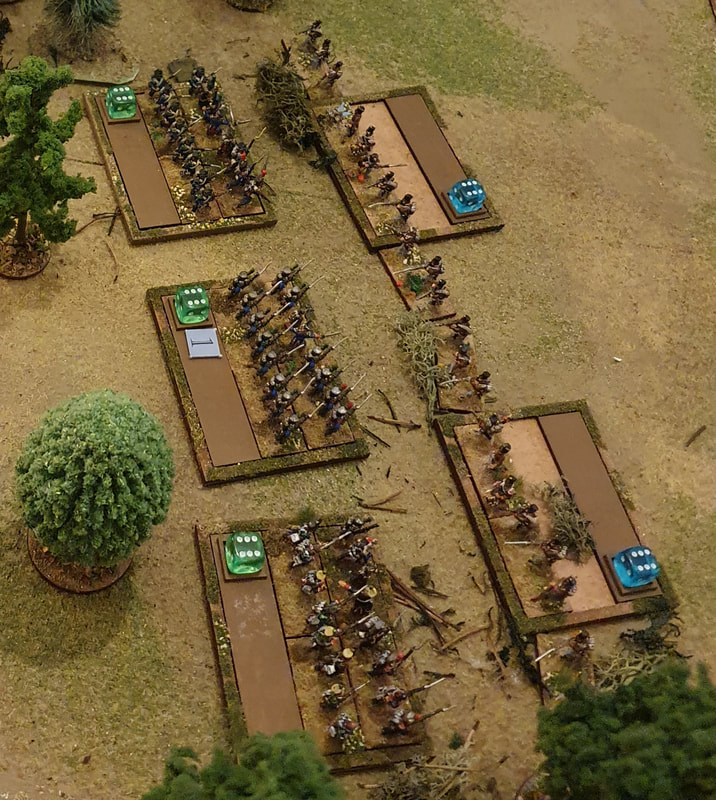


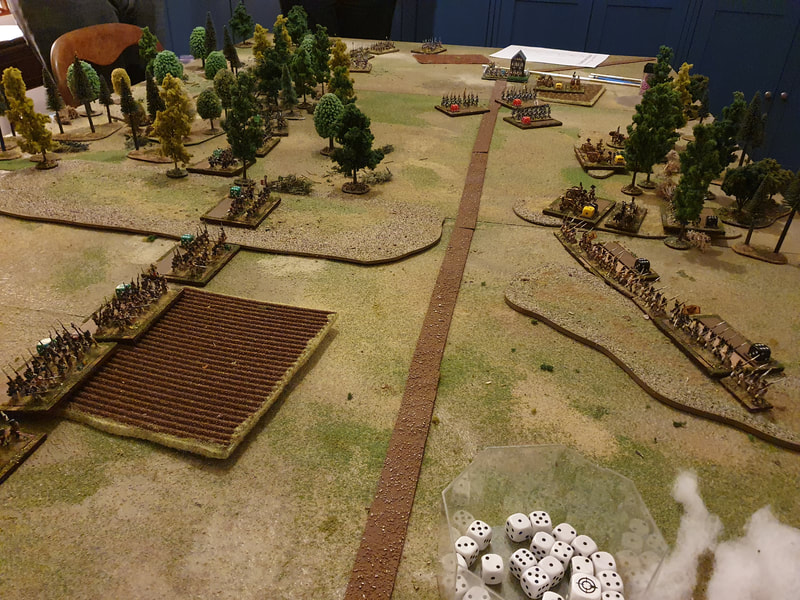



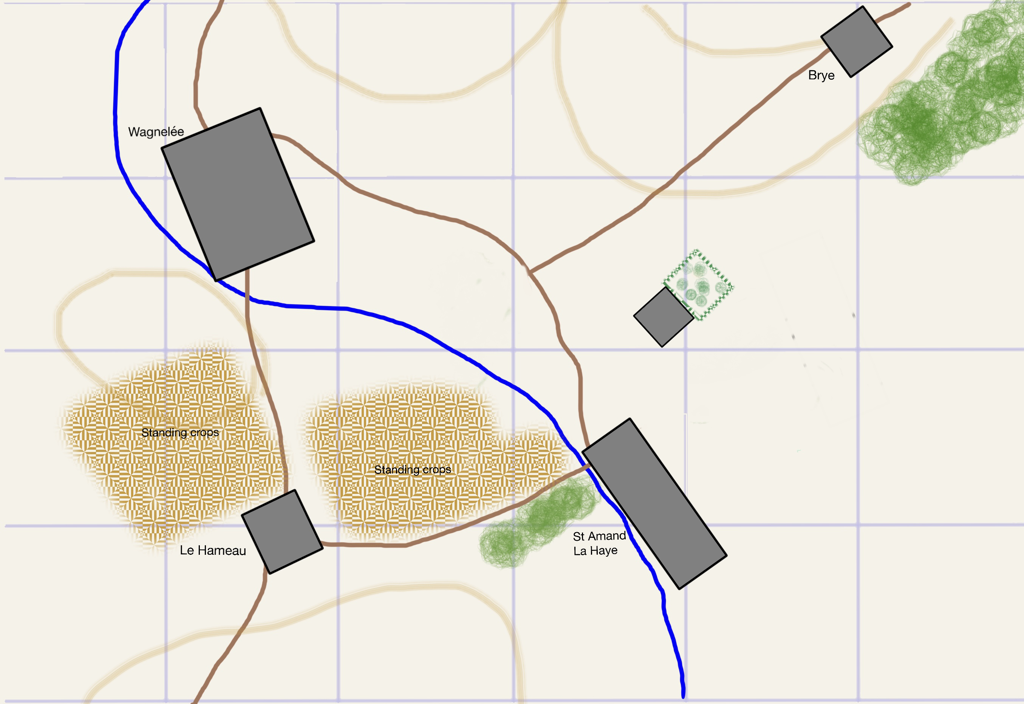

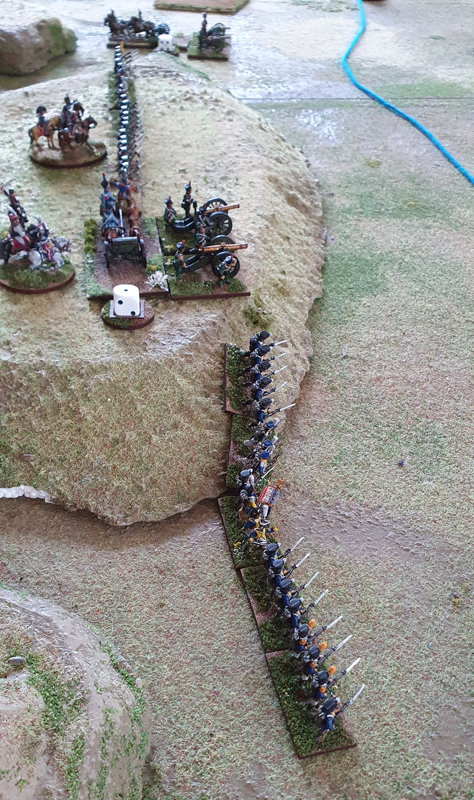


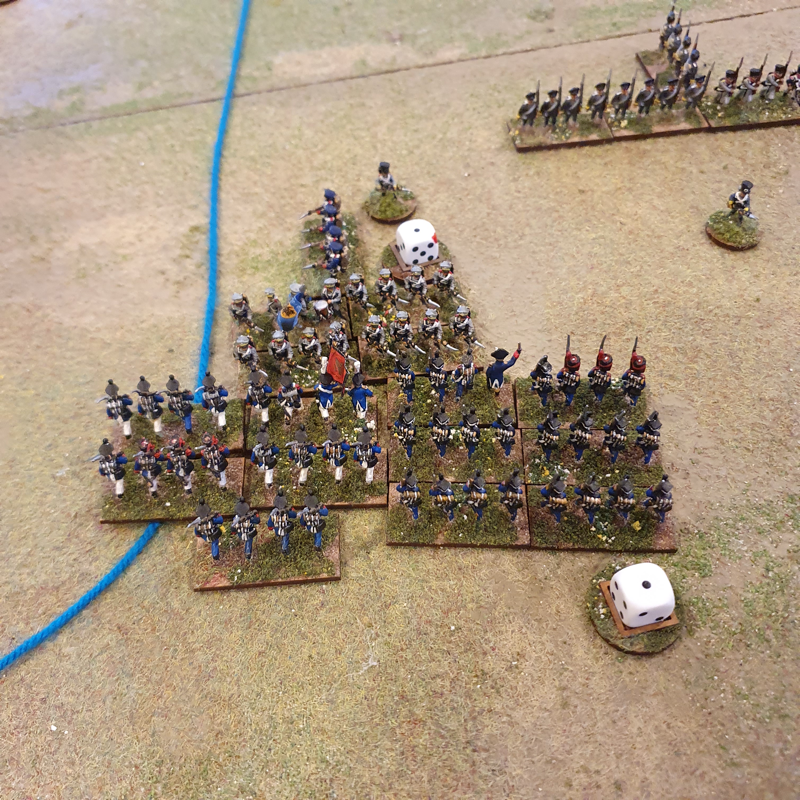


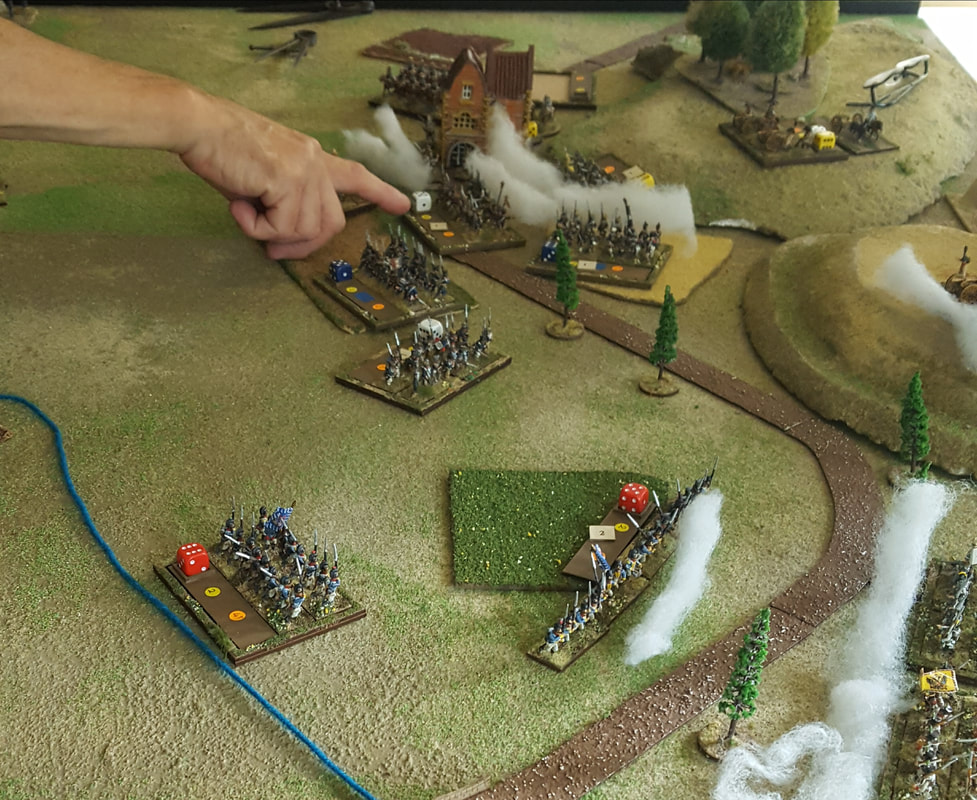


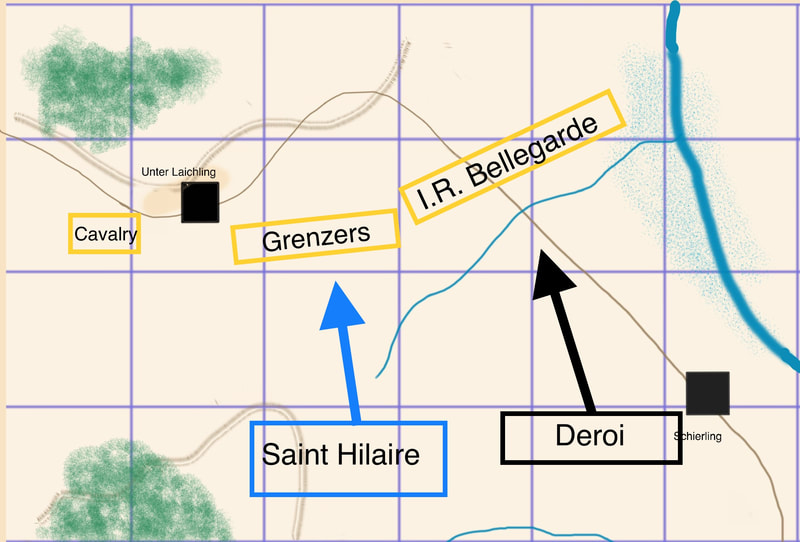
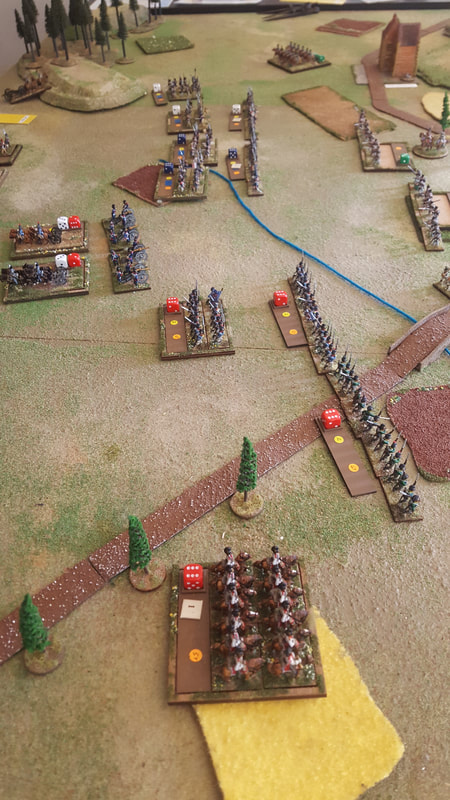

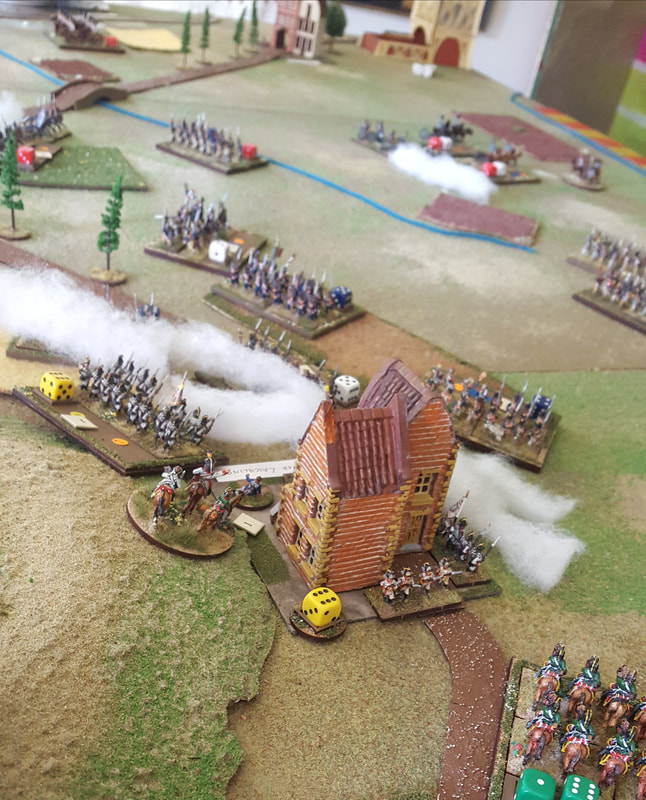
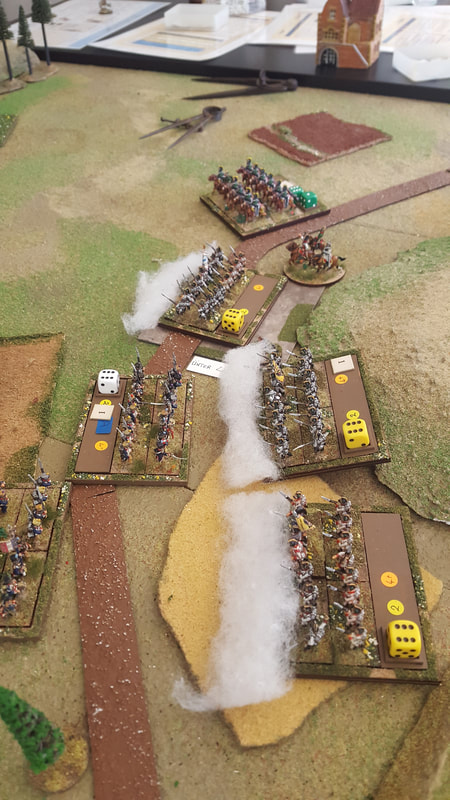

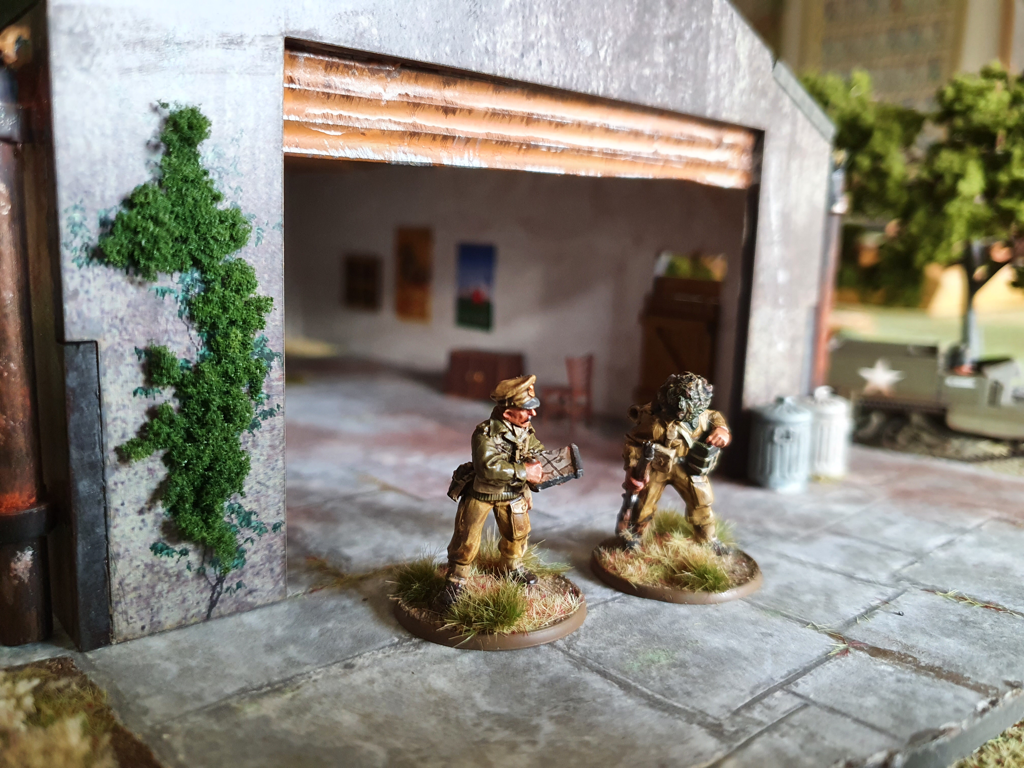








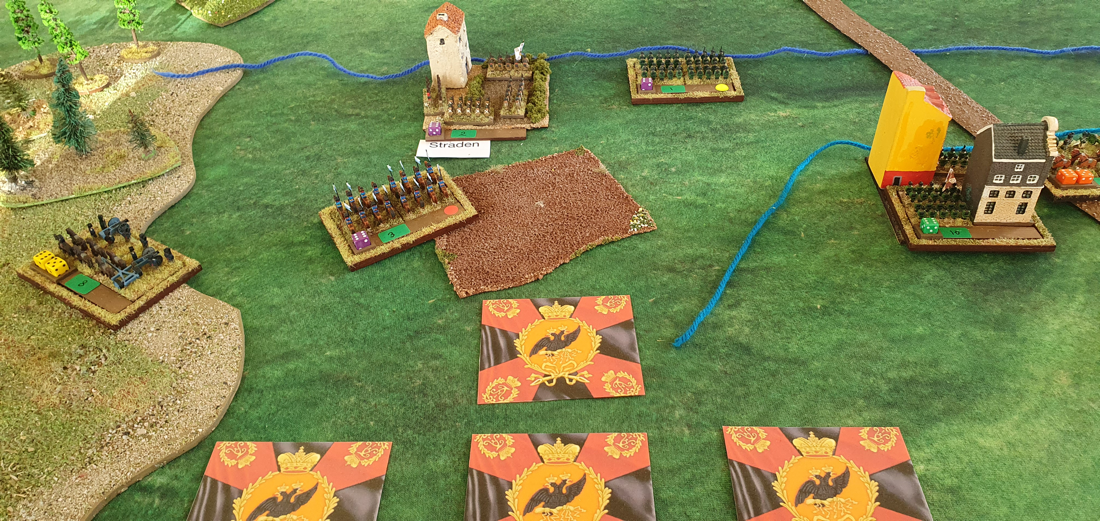
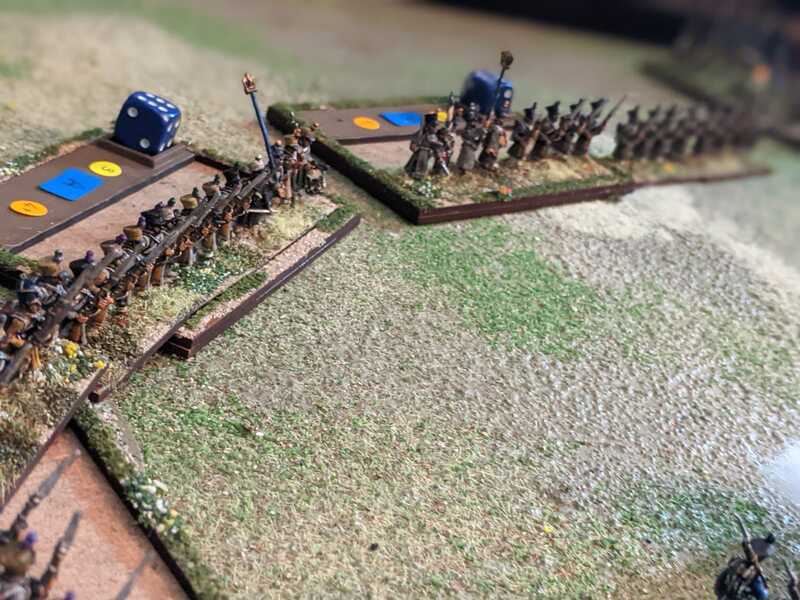

 RSS Feed
RSS Feed